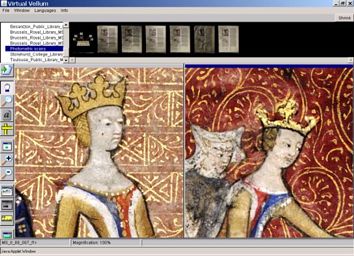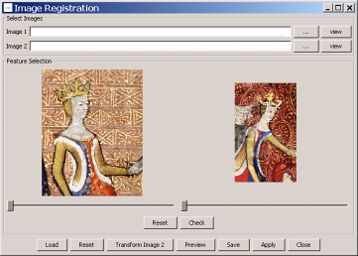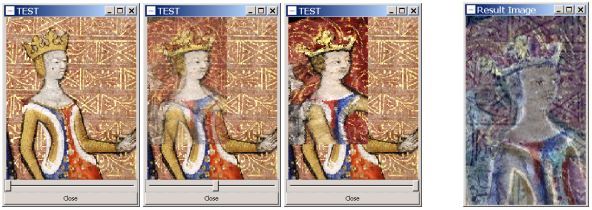Cyber Tools to Aid Understanding of the Medieval French Book Trade
Cyber Connoisseurship
The Art History, French and Medieval Studies programs at the University of Illinois are working together with NCSA to develop cyber tools for analyzing the visual imagery embedded in several early manuscripts of Jean Froissart's Chronicles, which have been successfully digitalized and mounted on the web and are available through Virtual Vellum (see also Virtual Vellum Overview). With the collaboration of a team at the University of Illinois and several European institutions, they have developed cyber tools for analyzing the visual imagery embedded in manuscripts.
Art historians have long used the practice of connoisseurship (a careful visual examination of a given work) to identify artistic hands. A central tenet of the approach is the assumption that, while artists might vary their general compositions, they will always consistently draw or paint routine elements, such as ears, eyes, hands, and drapery. The tools developed aid this endeavor by sorting large collections of data and enabling comparisons of colors, thus making it easier to differentiate between artists working in a similar style.
We use the term Cyber connoisseurship narrowly to describe the process of understanding through digital techniques and tools how artistic practice worked among manuscript producers in the late Middle Ages.









Our goal is to provide insight into both the construction of these specific Froissart manuscripts, and more broadly, the functioning of the medieval Parisian book trade. Through computer analysis of manuscripts and sorting of artistic hands, art historians gain an understanding of how groups of artists collaborated to create manuscript illuminations. They are able to identify artists that work together on a single project and in different combinations on several projects. The tools developed are available for downloading on the ISDA NCSA download web page. The tools have also become a part of the coordinated effort between the Medieval Studies at the University of Illinois, and the University of Sheffield, UK. The goal is to share access to data via Virtual Vellum hosted by the University of Sheffield over the Worldwide Universities Network, as well as to share software tools so that they may be applied to other families of manuscripts.
Color based artistic hand analyses of historical illuminations from Froissart's manuscripts
Using the Im2Learn tool, a color fingerprint for each artist may be identified by obtaining the color characteristics in one of many color spaces. Our initial experiments indicate that saturation and value levels in the HSV color space leads to the most discriminating characteristics of artistic hands. While this process initially required the manual segmentation of a region and search for the most discriminating color space, the development of our algorithms as both refined and largely automated the process.

Figure 1: Digital images were obtained from the rich corpus collected by the Online Froissart project (and accessible via Virtual Vellum). All of the digital surrogates analyzed for this project were captured using consistently applied image capture and handling protocols.

Figure 2: The Im2Learn tool successfully segments selected areas of an illumination for color space analysis. Here, a figure has been cropped from the larger composition and is prepared for segmentation and analysis.

Figure 3: Using the segmentation tool, a mask is created of the area to be analyzed. In this example, the face of the figure will be the point of analysis and eventual comparison.


Figures 4 & 5: The initial image and its corresponding mask are loaded into the Im2Learn Image Calculator. The resulting segmented image may be used to analyze the digital color of the specified area in alternate color spaces. In Figure 4, the HSV color space (identified by the team as the most significant indicator for artistic hands) has been applied to the segmented area of the figure. The calculator automatically calculates the color averages for each of the three characteristics of the color space (here the hue, saturation, and value of the color).

Figure 6: The collected data points are graphed and identifiable clusters are identified, indicating the hand of a particular artist.
Spatial registration of objects from Froissart's manuscripts
Figures below illustrate the first results obtained by analyzing Besancon and Brussels manuscripts using Image registration tool.


Figure 7. Left: Comparison of multiple zoomed regions from two manuscripts as shown in Virtual Vellum viewer. Right: View of the Image registration tool. The fiducial marks on the two images were used as control pairs of points for computing the affine transformation registration parameters.

Figure 8. Result of registration as an overlay of two illustrations sub-areas (with faces).
The result is shown in Figure 8 as a sequence of two image overlays with variable transparency (0, 50 and 100% transparency of the right image on the left image) as indicated by the slider bar on the bottom of each window. The user driven change of transparency parameter allows not only exploring the visual differences in the crown and the color pattern of the cloth but also quantifying the scaling offset of the mouth by each artist. The right image in Figure 8 was obtained by subtracting the registered images.
On-going Research
In Spring 2011, we turn to the analysis of secondary decoration to group the other anonymous artists who contributed to these manuscripts, namely the artists who paint two-line high champides or flourished initials throughout these manuscripts or the marginal baguettes (linear decorative elements) that distinguish pages with miniatures from other pages. Sorting out these multiple hands will give insight into the interactions and associations between various members of the book trade. But they will also offer an opportunity to document the scope of the collaboration between one Parisian libraire (book editor) and the diverse anonymous collaborators (artists, scribes and decorators) who worked with him and with others.
Once we have demonstrated the value of digital analyses of style, script, and secondary decoration, we hope that our results will stimulate a new generation of twenty-first-century scholars, humanists and scientists who will work together to understand the historical community of book producers active at a specific moment in the late Middle Ages.
Acknowledgments
This project has been funded by NCSA and NSF. We would like to acknowledge the NCSA Faculty Fellow program and the NSF IIS 09-10562 EAGER program for providing the funding.
Team members:
At the University of Illinois, USA:
- Anne D. Hedeman
Art History, School of Art and Design, UIUC - Peter Bajcsy
Image Spatial Data Analysis Group, NCSA, UIUC - Kevin Franklin
Institute for Computing in Humanities, Arts, and Social Science (I-CHASS), UIUC - Karen Fresco
Department of French, UIUC - Simon Appleford
Institute for Computing in Humanities, Arts, and Social Science (I-CHASS), UIUC - Jennifer Guliano
Institute for Computing in Humanities, Arts, and Social Science (I-CHASS), UIUC - Maryam Moslemi
Computer Science, UIUC - Tenzing Shaw
Electrical and Computer Engineering Department, UIUC - Heather Tennison
Art History, School of Art and Design, UIUC - Natalie Hansen
Art History, School of Art and Design, UIUC
In Europe:
- Professor Peter Ainsworth
Department of French, School of Modern Languages and Linguistics and Humanities Research Institute University of Sheffield, UK - Dr. Michael Meredith
Department of French, School of Modern Languages and Linguistics, University of Sheffield, UK - Dr. Godfried Croenen
History of the Book Research Group, School of Cultures, Languages and Area Studies, University of Liverpool, UK - Professor Christopher Allmand
Emeritus Professor of Medieval History, School of History, University of Liverpool, UK - Professor Alberto Varvaro
Dipartimento di Filologia Moderna, University of Naples "Federico II", Italy





